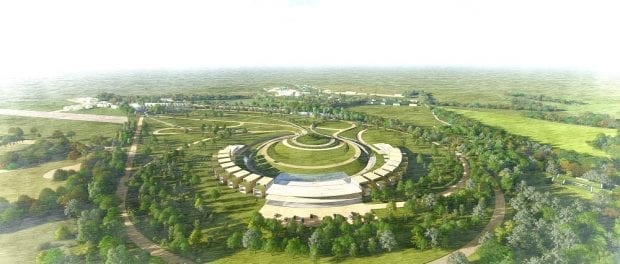Mullin Automotive Park receives outline planning permission

The West Oxfordshire District Council has awarded outline planning permission to the Mullin Automotive Park. The submission summarised proposals for a world-class automotive museum in the heart of the British countryside, rehabilitating a disused airfield on part of the site and generating local employment to support the growing community of classic automobile collectors.
Gerard Evenden, Head of Studio, Foster + Partners said, “We are delighted that the Mullin Automotive Park has cleared the first round of planning permission. A new countryside cultural destination, the project will support the wider community as well as providing a special experience for classic automobile collectors. We look forward to commencing detailed design for the next stage of planning.”
Peter Mullin said “I don’t regard myself as a collector of wonderful classic cars, but more as a custodian of a collection which I want to make available in a public forum well beyond my lifetime. My philosophy has always been to assist with education and innovation, and to illuminate the past for the benefit of the future. The impact of the automobile on our modern way of life deserves to be recorded in the most imaginative, educational and absorbing way possible.”
The museum seeks not just to capture the history of automobiles over the last century, but also to be an open-ended collection that charts the changing face of mobility in the future. It will be a centre of knowledge, education and excellence that showcases the extraordinary impact automobiles have had and will continue to have on our lives.
The design draws inspiration from the idea of a rural estate, a journey through a carefully considered landscape towards the main building that forms an integral part of the overall experience for visitors. A small cluster of workshop type buildings with visitor facilities including the ticket office and café are located at the entrance of the site. From here, visitors can walk to the museum at the heart of the site, nestled within the landscape.
Designed as a collection of buildings arranged in a crescent, the museum will be the focal point of the entire development, allowing for most of the site to remain as green parkland. The automotive park also features roads that are especially designed for ‘exercising’ cars from the Mullin collection, allowing visitors to have an immersive experience. The proposals also include a series of residential pavilions and landscaped lodges bringing automotive enthusiasts closer to their collections.
The built form of the museum will be orientated to maximise for thermal performance along with other passive measures and renewable technologies that minimise energy consumption. The proposal also addresses future flexibility and the ability to anticipate changes in the future.



